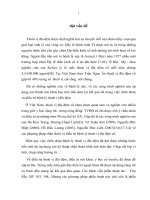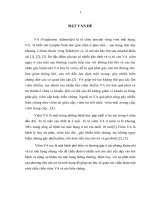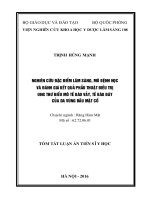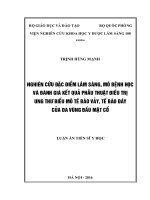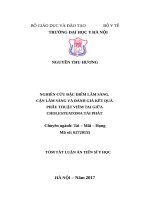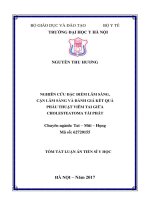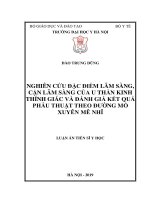Nghiên cứu đặc điểm lâm sàng, cận lâm sàng của u thần kinh thính giác và đánh giá kết quả phẫu thuật theo đường mổ xuyên mê nhĩ tt tiếng anh
Bạn đang xem bản rút gọn của tài liệu. Xem và tải ngay bản đầy đủ của tài liệu tại đây (701.18 KB, 27 trang )
MINISTRY OF EDUCATION & TRAINING MINISTRY OF HEALTH
HANOI MEDICAL UNIVERSITY
DAO TRUNG DUNG
CLINICAL, PARACLINICAL
CHARACTERISTICS OF ACOUSTIC
NEUROMA AND OUTCOMES OF SURGERY
VIA TRANSLABYRINTHINE APPROACH
Major
: Otorhinolaryngology
Code
: 62720155
SUMMARY OF DOCTORAL THESIS IN MEDICINE
HA NOI - 2019
THESIS COMPLETED IN:
HA NOI MEDICAL UNIVERSITY
Supervisors: PhD. Associate Professor. Le Cong Dinh
PhD. Associate Professor. Dong Van He
Reviewer 1: PhD. Associate Professor. Doan Thi Hong Hoa
Reviewer 2: PhD. Associate Professor. Vo Thanh Quang
Reviewer 3: PhD. Associate Professor. Nguyen The Hao
Thesis
will
be
defended
thesis assessment at
at
Commission
, date:
University.
Thesis can be consulted at:
- National library of Vietnam
- Library of Hanoi Medical University
for
PhD
in Ha Noi Medical
1
INTRODUCTION
Reasons for choosing this topic
Acoustic Neuroma (AN) is a benign neoplasm of the eighth nerve.
Because of the majority of tumors originates from the vestibular
nerve, only a small percentage (<5%) from the cochlear nerve, this
disease is also known as Vestibular Schwannoma (VS). This is the
most common type of tumors (> 80%) in the cerebellopontine angle
(CPA) and accounts for about 6-8% of all intracranial tumors. The
tumor can be either unilaterally or bilaterally in type 2
neurofibromatosis (NF2). When the tumor enlarges, it compresses the
cranial nerves in the internal auditory canal (IAC) and the CPA, the
brainstem, the cerebellum, eventually leading to increased
intracranial pressure (ICP). Due to its broad clinical manifestations
and its lack of specificity, early diagnosis of AN remains a subject
with great challenges.
Treatment for AN includes: surgery to remove the tumor,
radiation to stop the tumor growth and periodic monitoring by MRI.
Tumor removal via the occipital approach by neurosurgeons, which
has been performed for more than a century, has saved many lives,
but some disadvantages still exist with this approach such as
postoperative brain edema, difficult to remove the tumor out of the
IAC, cerebrospinal fluid (CSF) leakage. In the early 1960s, House –
an ENT doctor – had initiated the translabyrinthine approach (TLA),
which brought a huge change in the outcome of the tumor removal as
well as a significant reduction of complications. The use of
microscopes, VII nerve monitoring, ultrasonic suction makes surgery
safer and more effective. Therefore, TLA for AN surgery has widely
applied in the world. The combination of the two specialities – ENT
and Neurosurgery – has made the diagnosis and treatment of AN
more effective.
2
In Vietnam, AN is often detected in different specialties such as
Neurology, Neurosurgery, ENT when the tumor has reached
considerable size. Tumor excision has been done by the suboccipital
approach, but limitations still exist such as death rate of 4.2-21.4%,
peripheral facial nerve paralysis (PFP) is 91-100%. Tumor removal
through the TLA has not yet deployed. Therefore, studies of clinical
and paraclinical characteristics, and the linkage between them to
draw experience in the diagnosis and application of translabyrinthine
AN excision should be carried out. Based on the urgency of the
above issues, we conducted a study entitled "Study of clinical,
paraclinical characteristics of acoustic neuromas and outcomes
of surgery via translabyrinthine appoach".
Aims of study
1. To describe the clinical characteristics, audiogram, vestibular
function and imaging of the acoustic neuroma.
2. To assess the outcomes of translabyrinthine acoustic neuroma
surgery
NEW CONTRIBUTIONS OF THE THESIS
1. Description of the clinical, auditory, vestibular and imaging
features of acoustic neuromas.
2. Identification of the relationship between clinical and subclinical
characteristics in diagnosis of acoustic neuromas.
3. Effective application of the translabyrinthine approach in acoustic
neuroma surgery.
STRUCTURE OF THE THESIS
The thesis consists of 115 pages, introduction 2 pages, overview 31
pages, patients and methods 18 pages, results 21 pages, discussion 40
pages, conclusions 2 pages, recommendation 1 page. 28 tables, 6
charts, 28 figures, 4 photos, 1 diagram. 3 annexes (1 annex illustrated
surgery, 1 annexed medical records, 1 post-operative follow-up paper).
190 references including 175 english, 9 vietnamese, 6 french ones.
3
Chapter 1
OVERVIEW
1.1. Acoustic neuroma
1.1.1. History
1.1.1.1. Overseas
Early period: from 1777 to the end of XIX century
- Sandifort (1777) first described the tumor derived from the
eighth nerve.
- Charles Bell (1833): description of clinical of the tumor.
- Annadales (1895): first successful tumor excision.
In this period, the disease was diagnosed at a very late stage,
with the lack of medication and equipments, so patients often died of
brain herniation or surgical complications.
Neurosurgery period: to the early 1960s
- Krause (1777): suboccipital approach.
- Cushing (1917): intracapsular excision to reduce complications.
- Dandy (1925): total tumor removal to prevent recurrence.
During this period, the diagnosis of AN was often delayed when the
tumor had caused increased ICP. Surgery was performed by
neurosurgeons by suboccipital approach, aimed at saving patient life.
Neurotology period: after 1960
- House (1964): surgery by TLA and middle cranial approach.
- Leksell (1969): radiosurgery by Gamma Knife.
- Jewett and Williston (1971): auditory brainstem response (ABR).
- Delgado (1979): intraoperative facial nerve monitoring.
- 1987: gadolinium-enhanced MRI.
From this stage, the disease has been more likely to be
diagnosed sooner if patients present with hearing loss, dizziness or
tinnitus. The combination of otologists and neurosurgeons is wellsuited for effective tumor removal, along with preservation of the
facial nerve (FN) function and preservation of hearing.
4
1.1.1.2. Vietnam
- Nguyen Thuong Xuan (late 1970s): suboccipital AN surgery.
- Luong Sy Can, Le Thuong and Nguyen Tan Phong (1979):
imaging of the IAC with contrast injection for early AN detection.
- Duong Dinh Chinh (2001): study of AN characteristics in
conventional skull X-Ray and brain CT scan.
- Nguyen Van Sang (2007): MRI characteristics of AN.
- Vo Van Nho (2001), Dong Van He (2001), Ha Kim Trung
(2007), Nguyen Kim Chung (2014): suboccipital AN surgery.
1.1.1. Pathogenesis
AN is a benign schwann cell tumor. More than 95% of AN
originate from the vestibular nerves or vestibular ganglion, only a
small percentage of tumor is derived from the cochlear nerve. Most
tumors appear in the IAC, then develop into CPA.
The pathogenesis of AN relate to the NF2 gene mutation, which
is located on the long arm of chromosome 22 (22q12). Inactivation of
both alens of this gene leads to a deficiency in the merlin protein. The
lack of this protein leads to uncontrolled schwann cell growth and
tumor formation.
Figure 1.8. Schema of AN in the IAC and CPA.
5
1.1.2. Structure and progress
AN appearance is pale yellow or pinkish gray, smooth surface,
no real capsule, as firm as rubber. Most of tumors grow slowly with
the average diameter increase by 1.42 mm/yr, only 2% of tumor are
fast growing (> 2 mm/yr). About 4-22% are self-degraded over time.
1.1.3. Clinical presentations
1.1.3.1. Symptoms:
Typically, most patients complain unilateral, progressive hearing
loss, a small number has sudden sensorineural hearing loss. The less
frequent symptoms are tinnitus, dizziness. In the later stage, symptoms
such as facial numbness, headache, balance disorders may present.
1.1.3.2. Signs:
- Cranial nerve dysfunction: facial numbness, loss of corneal
sensation, Ramsay Hunt sign. Peripheral facial paralysis is rare.
- Spontaneous nystagmus may occur: horizontal or vertical.
- Peripheral vestibular syndrome (early stage) or central vestibular
syndrome (late stage).
- Increased ICP syndrome.
- Brainstem syndrome: in the very late stage, hemiparalysis, lower
cranial nerve paralysis.
1.1.4. Paraclinical characteristics
1.1.4.1. Audiometry:
- Pure tone audiometry: unilateral perception or bilateral and
asymmetrical hearing loss. Some patients may have normal hearing
threshold. The most common configuration is down-sloping, less
frequent patterns are flat, up-slopping, trough and inverted-trough.
- Speech audiometry: threshold increase > 10 dB in comparison
with pure tone threshold. Word discrimination score < 100%.
Speech audiogram is rollover pattern.
- Auditory brainstem response (ABR): conduction block, typical
for retrocochlear lesion.
6
1.1.4.2. Vestibular manifestations:
- Caloric test (water 44oC and 30oC or air 50oC and 24oC): reduced
or no response, Unilateral Weakness (UW) index > 22%.
- Vestibular evoked myogenic potential: decrease myogenic
potential responding to loud click stimuli to the ipsilateral ear.
1.1.4.3. MRI: “gold standard” for diagnosis
- Spherical or pear shaped tumors in the IAC and CPA, isointense
to gray matter in T1, hyperintense in T2, intense contrast
enhancement but may heterogenous in large tumors.
1.1.4.4. Temporal bone CT: erosion and widening of the IAC
(trumpeted shape) in bony window.
1.2. Surgery
1.2.1. Objective
Remove the tumor to reduce intracranial compression.
1.2.2. Indications:
- Greatest tumor diameter in the CPA > 30 mm.
- Significant hearing loss (PTA > 50dB, WDS < 50%).
- Cystic tumors.
- No response to radiation therapy.
- Bilateral tumor in NF2.
1.2.2. Approaches
- Suboccipital approach (retrosigmoid).
- Translabyrinthine approach (presigmoid).
- Middle cranial approach.
1.2.3. Translabyrinthine approach
Indications:
- Tumors of any size with unserviceable hearing (PTA > 50 dB,
WSD < 50%).
- Tumor diameter in the CPA > 20 mm (because the chance of
hearing preservation is very low).
7
Technique:
- Extended mastoidectomy.
- Posterior labyrinthectomy (remove all three CSCs and vestibule).
- Exposure of IAC and CPA.
- Tumor excision.
- Closure with fat and fascia lata.
Figure 1.20. Translabyrinthine approach.
Priciples of tumor excision:
- Begin with intracapsular reduction, then dissect the tumor surface
from the surrounding neural structures and blood vessels.
- The facial nerve (FN) is located at the consistent landmark at the
IAC fundus (above the transverse crest, in front of the Bill’s
bar) and at the brainstem. Use the FN probe while dissecting.
- Cauterize only the blood vessels that run into the tumor,
preserve the surrounding arteries and veins to avoid
complications on the brainstem and cerebella.
Advantages:
- Can be applied for tumors of any size in the IAC and CPA.
- Allow FN be found before tumor excision.
- Less brain complications, low CSF leakage incidence.
- Intra-operative FN reconstruction (in case the FN was sectioned).
Disadvantages:
- Residual hearing sacrifice.
- More operation time is needed.
8
Chapter 2
PATIENTS AND METHODS
2.1. Patients: 50 patients who were diagnosed with AN and
underwent surgery via translabyrinthine approach at the VietDuc
Hospital from September 2012 to May 2017.
2.1.1. Selection criteria
- Patients were diagnosed with AN by mean of gadoliniumenhanced MRI.
- Indicated for surgery.
- Underwent clinical examination, caloric test, puretone
audiometry and temporal bone CT scan.
- Had surgery for the first time, via translabyrinthine approach:
indicated for tumor with diameter ≥ 11mm and/or hearing loss
with PTA > 50 dB.
- Post-op histopathological findings confirmed schwann cell tumor.
- Had been monitored and periodically evaluated after surgery.
- Agreed to participate in research.
2.1.2. Exclusion criteria
Acoustic neuroma patients but:
- Tumor on the only hearing ear.
- Tumor diameter < 20 mm on the better hearing ear.
- Active infection in the middle ear and nose.
- Diseases that were contraindicated to surgery.
2.2. Methods
2.2.1. Research design: prospective study, case series with
intervention without comparison group.
2.2.2. Sampling: purposive sampling of 50 patients who met the
selection and exclusion criteria.
2.2.3. Research steps
- Step 1: research approval, preparation of medical records.
- Step 2: clinical examination and paraclinical tests to describe
and examine the relationship between the clinical, vestibular,
audiometrical, CT and MRI characteristics of AN.
9
- Step 3: surgery through translabyrinthine approach, intraoperative evaluation on the tumor removal and factors affecting
to the tumor removal and complications.
- Step 4: evaluation of the results of surgery at the first day, 6 months
and 12 months and at the end of the study on clinical symptoms,
complications, tumor recurrence and residual tumor regrowth.
- Step 5: data process and thesis writing.
Diagram 2.1. Steps to recruit patients into the study.
2.2.4. Criteria for evaluation
- Symptoms: frequency, time and grade of common symptoms
(hearing loss, tinnitus, dizziness, facial numbness, headache).
- Signs: nystagmus, loss of facial sensation, PFP.
10
- Vestibular examination: may show peripheral or central
vestibular syndrome.
- Caloric test with warm water 44oC and cold water 30oC. The
evaluation of induced nystagmus included the latency (time
from the irrigation of water to the beginning of nystagmus) and
the duration of nystagmus (time from the appearance to the end
of nystagmus). We calculated the Unilateral Weakness (UW)
index according to Jongkee
UW =
(WR+CR)−(WL+CL)
WR+CR+WL+CL
x 100
Classification of UW according to Teggi: Class A <25%, Class
B: 25-50%, Class C: 50-75%, Class D:> 75%.
- Pure tone audiometry: based on the pure tone average (PTA) as
an average of hearing thresholds (decibels) at 500-1000-20004000 Hz, we classified hearing as normal hearing: 0-15 dB, mild
hearing loss 16-40 dB, moderate 41-70dB, severe 71-90 dB,
deafness > 90 dB. Classification of audiograms: horizontal,
upward, downward, hill, trough, unspecified.
- MRI: tumor characteristics (size, density, extent to the fundus of
the internal auditory canal).
- Temporal bone CT: shape, size of the IAC.
- Tumor removal: complete or incomplete.
- Complications: intraoperative, post-operative.
- Effect of surgery on clinical symptoms.
- Tumor recurrence and regrowth of residual tumors.
2.2.5. Studying time: from September 2012 to May 2017.
2.2.6. Studying location:
- Neurosurgery center, Vietnam German Friendship Hospital.
- ENT department, Bach Mai Hospital.
- ENT department, Vietnam Cuba Friendship Hospital.
2.2.7. Data analysis: SPSS 16.0 software with appropriate statistical
algorithms.
11
Chapter 3
RESULTS
3.1. Clinical and paraclinical characteristics of acoustic neuroma
3.1.1. Demography:
- 50 patients (16-71 years old). Female : male ratio = 1,63.
- Most common age group: 41-60 (58%) and 20-40 (28%).
3.1.2. Clinical presentations:
3.1.2.1. Common symptoms:
Table 3.3. Common symptoms (N = 50).
Symptoms
n
%
Hearing loss
47
94.0
Dizzy
35
70.0
Tinnitus
34
68.0
Headache
33
66.0
Hemifacial paresthesia
33
66.0
3.1.2.2. Signs:
Table 3.5. Signs (N = 50).
Signs
n
%
Hemifacial paresthesia
31
62.0
Hitselberger
29
58.0
Loss of corneal sensation
25
50.0
Spontaneous nystagmus
15
30.0
Peripheral facial paralysis
1
2.0
3.1.2.3. Caloric test:
- Most of the ear with tumor was not responding to caloric test:
94.2% with water 44°C and 88.5% with water 30°C.
- 88% of patients had unilateral weakness index > 22%.
12
3.1.3. Paraclinical findings:
3.1.3.1. Audiometry:
- 98.1% ears presented sensorineural hearing loss. The highest
rates were deafness (50%), followed by moderate to severe
hearing loss (32.7%). One patient (1.9%) had a normal hearing.
Table 3.9. Audiometry configuration (N = 52).
Configurations
n
%
Downward
18
34.6
Horizontal
8
15.4
Upward
4
7.7
Trough
2
3.8
Hill
1
1.9
Unclassified
19
36.5
Total
52
100.0
3.1.3.2. MRI:
- 48 patients had tumor on one side, two patients had on both
sides.
- Size: moderate 21.1%, large 30.8%, giant (48.1%).
- Density: 61.5% solid tumor, 38.5% mixed.
- 80.8% reached the fundus of the IAC.
Figure 3.1. Tumor photos in MRI images.
A. Medium, solid tumor that had not spread to the fundus (record 16453).
B. Large, mixed tumor that had spread to the fundus (record 22673).
C. Giant, mixed tumor that had reached the fundus (record 32059).
D. Bilateral tumors that had reached to the fundus (record 28823).
13
3.1.3.3. Temporal bone CT:
- 82.7% of the IAC with tumor was funnel-shaped.
- 90% of patients had IAC different in shape on both sides.
- 57.7% of IAC with tumor enlarged with diameter > 8mm.
3.2. Evaluation the results of surgery
3.2.1. Tumor removal:
Table 3.19. Results of tumor removal (N =50).
Results of tumor removal
n
%
Complete
24
48.0
Incomplete
26
52.0
Total
50
100.0
Figure 3.2. Intraoperative photos (record 26567).
A. The pear shaped tumor in the IAC and CPA. B. Tumor was
completely removed with preservation of cranial nerve V, VI, VII, IX.
Figure 3.3. Complete tumor removal in MRI image (record 22673).
Figure 3.4. Incompletely tumor removal in MRI image (record 7960).
14
3.2.2. Complications
Table 3.21. Intraoperative complications (N = 50).
Intraoperative complications
n
%
Bleeding
2
4.0
Section of cranial nerves
0
0.0
No complication
48
96.0
Total
50
100.0
3.2.3. Post-operative complications
Table 3.22. Post-operative complications (N = 50).
Post-operative complications
n
%
Peripheral facial paralysis
26
52.0
Pharyngoparalysis
2
4.0
Oculomotor paralysis
1
2.0
Wound infection
1
2.0
Mortality
0
0.0
Intracranial haemorrhage
0
0.0
Meningitis
0
0.0
Hemiplegia
0
0.0
3.2.4. Effects of surgery on clinical symptoms
Table 3.27. Effects of surgery on clinical symptoms.
Before
surgery
(N = 50)
After 6
months
(N = 50)
After 12
months
(N = 44)
n
%
n
%
n
%
Tinnitus
34
68.0
17
34.0
15
34.1
Facial paresthesia
33
66.0
15
30.0
13
29.5
Headache
33
66.0
1
2.0
1
2.3
Dizzy
35
70.0
4
8.0
0
0.0
Symptoms
15
3.2.5. Recurrence tumors and residual tumors grow back
Table 3.28. Tumor recurrence and residual tumor regrowth (N =50).
Groups
n
%
Complete tumor removal (n = 24)
0
0.0
Incomplete tumor removal (n = 26)
4
15.4
Chapter 4
DISCUSSION
4.1. Clinical and paraclinical characteristics of acoustic neuroma:
4.1.1. Demography
AN was more common in women (female : male ratio = 1.63),
similar to Vo Van Nho (1.47), Teggi (1.94), Lee (1.48), Bento (1.3).
Some factors that may favor preponderance in females were
endocrine (hormone estrogen and progesterone), gender (generally
skull in women was smaller and can not bear the intracranial
compression as men), physiological (women had less physical
activities, so compensation to balanced disorders were slower).
The median age was 50, the most common age group was 41-60
years (58%). Because most tumors progressed slowly (at an average
of 1.42 mm in diameter per year), probably when the tumor was large
enough to expose clinical presentations.
4.1.2. Clinical presentations
4.1.2.1. Common symptoms
Hearing loss was the most common symptom (94%), with the
earliest manifestation in time. The majority was progressive hearing
loss by 91.5%, then sudden sensorineural hearing loss was 8.5%.
This was the consequence of both cochlear and retrocochlear lesions.
Dizziness occurred in 70%, about two thirds was mild that did not affect
to movement, consistent with the characteristics of slow progressive
tumors, so the central nervous system had been compensated.
16
Tinnitus accounted for 68%, the rate of low-pitched and highpitched tinnitus was equivalent and had little impact on life.
Headache was 66%, located at occipital regions and did not
accompany by symptoms of increased ICP syndrome. The
mechanism may due to stimulation of tumor on the meninges, led
patients to taking analgesic with equivocal result.
Hemifacial paresthesia was 66%, which was higher than that of van
Leeuwen (22%), Lanman (30%). This symptom was significant for
tumor compression on the trigeminal nerve in the CPA.
4.1.2.2. Signs
Cranial nerve dysfunctions: the most common was trigeminal
nerve dysfunction (62 hemifacial paresthesia, 50% corneal sensation
loss) and FN (Hitselberger sign 58%). Only one patient (2%) had
PFP, which was consistent with the characteristics of the motor fibers
that can withstand to compression and twisting better than the
sensational fibers. No case of IX-X-XI paralysis.
Balance disorders: 30% of patients had spontaneous nystagmus,
meaning that the balance system had not been fully compensated.
100% of patients had vestibular syndrome, in which 38% was
peripheral type and 62% was central type, meaning the cerebella and
brainstem had been compressed by large tumors.
4.1.2.3. Caloric test
The majority of ears with tumors did not respond to warm water
stimulation at 44°C (94.2%) and cold water at 30°C (88.5%). This
was the result of one or more of the following mechanisms: (a) tumor
blocked the neural impulses from the superior vestibular nerve, (b)
compression on the blood vessels supplying the inner ear and
superior vestibular nerve, causing vestibular and horizontal
semicircular canal damage, (c) microinvasion of the tumor on the
axons of the superior vestibular nerve. The result was qualitative, its
value was to suggest lesions on the unresponsive ear.
17
88% of patients had significant unilateral weakness value (UW >
22%), similar to results of Hulshof was 87%, Tringali was 86%, less
than that of Berrettini was 92,3%, higher than Kentala was 66%. The
UW index was quantitative, highlighting the difference between two
ears, particularly in cases the ear with tumor still responded to caloric
stimulation. However, UW < 22% were found in 6/50 patients (12%)
with 4/6 tumors on one side and 2/6 tumors on both sides, suggesting
that the index had diagnostic value if abnormal, but was hard to
conclude if UW < 22% (there may be no tumors, tumor on both
sides or one side with central compensation). Therefore, caloric
testing should combine both qualitative and quantitative evaluations.
4.1.3. Paraclinical presentations
4.1.3.1. Audiometry
Hearing levels: 98.1% of the ears with tumors was sensorineural
hearing loss, the most frequent was deafness (50%), followed by
moderate to severe hearing loss (32.7%), higher than Bento in
deafness (26.7%) and moderate to severe hearing loss (65.4%),
higher than those of Lee with deafness (13.8%) and moderate to
severe hearing loss (20.6%). The median PTA of the ear with tumors
was 84 dB, higher than that of Hulshof with a PTA of 60 dB. This
showed that our patients had more hearing impairment than those of
foreign authors.
Audiogram configurations: all types of patterns were
encountered, the most common of which were downward (34.6%)
and unspecified (36.5%). The variety of audiograms may be due to
the combination of many causes such as various levels of cochlear
nerve axonal conduction due to repeated myelin loss and regeneration
resulting in multiple layers of schwann cells interspersed with
collagen fibers; the biochemical disturbance resulted in a 5-15 fold
increase in protein concentration, leading to an increase in inner ear
viscosity, which resulted in cochlear damages such as degeneration
18
of blood vessels, spiral ligament, inner and outer hair cells, inner ear
fluid retention, decreased blood supply to the inner ear and
congestion due to tumor compression on the arteries and veins of
vestibular aqueduct and cochlear aqueduct. In general, there was no
audiogram typical for acoustic neuroma.
4.1.3.2. MRI findings
48 patients (96%) had unilateral tumor and 2 patients (4%) had
tumor on the two sides, in accordance with epidemiology of AN.
Size: giant tumors was 48.1%; followed by large tumors (30.8%)
and medium tumors (21.1%). Median diameter was 39.5 mm, which
was higher than that of foreign authors such as van Leeuwen was
26.5 mm, Merkus was 17 mm, Berrettini was 26 mm, Mangus was
23.8 mm. Patients in our study had been found the disease at
relatively late stage.
Density: the number of mixed tumors increased with tumor size,
(0% in the medium tumor group, 43.8% in the large group (26-40
mm) and 48% in the giant group.
Degree of tumor invasion to the IAC fundus: 80.8% of the
tumors had invaded to the fundus. Because the tumor usually
originates from the transition zone between the schwann cell and the
oligodendrocyte (Obersteiner-Redlich region) or in the vestibular
ganglions near the IAC fundus, so the tumor tends to extend to the
fundus sooner. This invasion did not relate to the size of tumors.
4.1.3.3. Temporal bone CT
IAC shape: 82.7% of the IAC with tumor had funnel shape, contrast
to IAC without tumor (only 4.5% was funnel-shaped). 90% of
patients had difference in shape of IAC in both sides, which only
occurred in about 11% normal people. The presence of the tumor had
caused the deformation of IAC into funnel shape by the pression on
the walls of the IAC, resulting in increased bone turnover especially
near the porus region.
19
IAC diameter: mean diameter of the IAC with tumor was
statistically significant higher than IAC without tumor on both
horizontal and vertical planes. The difference was most pronounced
in the horizontal plane with mean diameter of the IAC with tumor
was 9.9 ± 3.96 mm (IAC without tumor was 5.2 ± 1.24 mm); the
diameter of the porus was 12.5 ± 3.69 mm (IAC without tumor was
8.0 ± 2.01 mm). However, only 57.7% of the IAC with tumor had a
diameter > 8 mm.
4.2. Evaluation the results of surgery
4.2.1. Tumor removal
The complete removal was 48% and incomplete removal was
52%. Our results are lower than that of other foreign authors such as
Mamikoglu was 95,1%, Sanna was 85,1%, Talfer was 79%.
The number of complete removal reduced with tumor size (60%
for medium and large tumors, 36% for giant tumors). The main
reason we had to leave a part of the tumor was because of adhesion
between the tumor and the facial nerve and the brainstem. The
complete removal in the solid density group was 40%, lower than the
mixed group was 60%; in the group without fundus extension was
60%, higher than the group with extension was 45%. However, these
differences are not statistically significant.
In our opinion, beside the aim of preserving the FN function, the
experience of neurosurgeons was the factor that affected to the results
of tumor removal. The change of surgical field from the familiar
suboccipital to translabyrinthine approach made them some
difficulties in the early stages of application (especially finding and
orientation of FN in the IAC and CPA). According to some studies,
the good results of AN surgery (high rate of complete tumor removal
and minimization of complications, especially PFP) were usually
achieved after 56-60 cases.
20
4.2.2. Complications
4.2.2.1. Intraoperative complications
Only two cases (4%) had bleeding, including one due to jugular
bulb tear in the process of exposing the IAC, which was control by
gentle compression with Surgicel and cottonoid; one due to a
rupture of a vein during excision the CPA, which was stopped by
vascular clip. This complication can be prevented by using large
diameter diamond drill that allowed us to remove the bone and to
leaves the periosteum, which provided better protection on the blood
vessel walls while allowing compression as needed to expand
surgical field; gentle manipulation during tumor dissection following
the plane of arachnoid membrane and we should not be aggressive if
the tumor was too adhered to the blood vessels.
We did not have any case of cranial nerve VII-IX-X-XI sectioned.
This was the advantage of translabyrithine approach because we found
the FN before tumor dissection and we did not need to compress the
cerebellar hemisphere as what we had to do with the suboccipital
approach, so we minimized traction on nerve IX-X-XI.
4.2.2.2. Post-operative complications
Severe complications: no mortality, no intracranial
haemorrhage, meningitis or hemiplegia. Those results were better
than the mortality rate for suboccipital approach of Dong Van He was
21.4%, Nguyen Kim Chung was 4.2%, Ha Kim Chung was 2.8% and
was in accordance with the literature that the mortality rate for
translabyrinthine approach was very low, ranging from 0-2%.
Peripheral facial paralysis: was the most common complication
(52%, including 20% mild paralysis and 32% severe paralysis). Our
postoperative PFP was lower than that of Lanman (61.4%, with 28% mild
paralysis and 33.4% severe paralysis) but higher than that of Brackmann
21
(27%, with 15.8% mild paralysis and 11.2% severe paralysis), Ho was
40% with 22.9% mild paralysis and 17.1% severe paralysis.
In terms of tumor removal: PFP in the incomplete removal
group (38.5%: 11.5% mild and 26.9% severe paralysis) lower than
complete removal group (66.7%: 29.2% mild and 37.5% severe
paralysis). PFP was more common in the complete removal group
was due to the need for more manipulation, both direct during tumor
dissection (FN may be section, burn or twist) and indirectly in the
process of tumor removal (causing the FN to be twisted). So, the
widely accepted opinion is not to try to make a complete tumor
resection if the FN integrity is not secured.
In relation to tumor characteristics: PFP increased with tumor
size, higher in the mixed density group (60%: 40% was severe
paralysis) than the solid group (46.7%: 26.7% was severe paralysis),
higher in the group that tumors had extended to the IAC fundus (55%:
35% severe paralysis) than the non-extended group (40%: 20% severe
paralysis). However, these differences were not statistically significant.
Follow-up showed that all patients who did not have PFP
immediately after surgery did not paralyse after 6 and 12 months;
PFP decreased from 52% immediately after surgery to 42% after 6
months and 38.6% after 12 months; Severe paralysis reduced from
32% immediately after surgery to 24% after 6 months and 25% after
12 months. This finding was consistent with Ho's finding that
postoperative PFP at all grades can be improved over time.
Other cranial nerve paralysis: one patient had cranial nerve VI paralysis
and two patients suffered from pharyngeal paralysis due to trauma to the
cranial nerve IX-X. These paralysis fully recovered after 1 month.
Cerebrospinal fluid leakage: no patient suffered from this
complication. To minimize CSF leak, we need to do the following:
22
- Preparation of the skin and musculo-periosteal flaps at the time
of skin incision to suture in two separate layers later.
- Fully occlusion of the ET and attic by periosteum and bone wax.
- Do not perform posterior tympanotomy.
- Reconstruct the meninge with fascia lata reinforcement.
- Obliteration of the mastoid cavity by fat.
- Use compression bandage for 3-5 days after surgery.
4.2.3. Effect of surgery on common symptoms
Dizziness was the most significant decrease, from 70% before
surgery to 8% at 6 months and 0% at 12 months. This was due to the
reduction of tumor compression on the cerebellum and brain stem,
posterior labyrinthectomy and stopped the abnormal neural impulses
from the vestibular nerves, allowing the balance system to be quickly
compensated under the control of the central nervous system.
Headache: decreased from 68% before surgery to 2% after 6
months and 2.3% after 12 months, due to decrease in tumor irritation
on the meninges and pression on the brain.
Hemifacial paresthesia: decreased from 66% before surgery to
30% after 6 months and 29.5% after 12 months, as the tumor was
removed or reduced in volume, resulting less compression of V nerve.
Tinnitus: decreased from 66% before surgery to 34% after 6
months and 34.1% after 12 months. May the labyrinthectomy help to
remove irregular nerve impulses from the inner hair cells.
4.2.4. Tumor recurrence and residual tumor regrowth
None of the 24 patients with complete tumor removal had
recurrence after a median of 12 months of follow-up (6-30 months).
In 26 patients with incomplete tumor removal, after a median of
24 months of follow-up (6-53 months), there were 4 cases of tumor
regrowth, accounting for 15.4%.
23
CONCLUSIONS
1. Clincial and paraclinical characteristics of acoustic neuroma:
The AN was most common in the age group of 41-60 years (58%),
followed by 21-40 years (28%). Women was more than men (ratio 1.63).
Symptoms: ear symptoms were prominent
- Hearing loss: most common (47/50: 94%), with earliest appearance.
91.5% (43/47) was progressive and 8.5% was sudden deafness.
- Dizziness: 70% (35/50), mostly mild degree.
- Tinnitus: 68% (34/50), equal rate of low-pitched and high-pitched.
Signs: vestibular syndrome and cranial nerve V, VII dysfunctions
- 100% of patients had vestibular syndrome, 38% was peripheral type.
- Hemifacial paresthesia (V dysfunction): 62% (31/50).
- Hitselberger sign (VII dysfunction): 58% (29/50).
MRI:
- The majority were unilateral (96%), only 4% was bilateral tumors.
- 78.8% were large and giant tumors, 61.5% was solid tumors,
80.8% of tumor had extended to the fundus of IAC.
valuable for the diagnosis and evaluation of tumor characteristics.
Hearing:
- Sensorineural hearing loss was 98.1% (51/52 ears). 82.7% was
moderate to severe hearing loss. The degree of hearing loss was
moderately correlated to the tumor diameter.
good for diagnosis and indication of translabyrinthine approach.
Caloric test:
- 94.2% of the ears with tumor did not respond to water 44oC and
88.5% to water 30oC. 88% of patients had unilateral weakness >
22%, regardless of tumor size.
indicated there were damages to the vestibule and vestibular nerve.
Temporal bone CT:
- IAC deformations: funnel-shaped (82.7%), widened > 8 mm
(57.7%), difference in shape of the IAC on both sides (90%).
diagnosis and assessment of anatomy for translabyrinthine approach.
